The Reflectorization of D.C. License Plates
The first District of Columbia plates to be reflective were made with Scotchlite sheeting and were introduced during March 1962 for the 1962-63 registration year. A few experimental 1962 glass-beaded plates were made, and some were apparently used. All have low registration numbers assigned by the Commissioners. They are unusual among plates reflectorized with this method in that the entire plate is covered with a glass-bead finish, not just the embossed areas. For all intents and purposes, however, the only method ever used to give D.C. plates a reflective quality is the sheeting pioneered by 3M. With the exception of some non-passenger plates and permits, such as plates issued annually to dealers into the 1970s, all D.C. plates issued since 1962 have featured a reflective background.
Foundation for Reflectorization Laid in 1960
Although we do not have a complete documentary history of how this important change to D.C. plates came about, we have enough materials to understand essentially how it happened. By Feb. 29, 1960, the date of our earliest DMV memorandum on this subject, relevant discourse was already under way. In the memo, DMV Director George A. England references a memo recently prepared by Mr. Schuyler Lowe, Director of the D.C. Department of General Administration, in which Mr. Lowe apparently argued that the additional cost required to manufacture reflective plates should be borne by the District government, not D.C. vehicle owners, for Mr. England uses his memo to refute this position. Fortunately for us, in making his point he writes "The idea of reflectorizing our plates originated with the Citizens' Traffic Board," which sounds like a community organization that addressed traffic-related matters of concern to D.C. residents collectively. "Since then," continues Mr. England, "following demonstrations, additional groups have indicated their desire that the program be adopted." Back in the days when license plate reflectivity was still a relatively new concept, manufacturers and suppliers of materials used in their construction routinely staged night-time demonstrations for lawmakers, DMV and law enforcement officials, community leaders, and others involved in the decision-making process. Such demonstrations often were held at closed airfields, with cars adorned with various types of plates placed alongside a runway. Vehicles in which potential customers were carried were driven in such a manner as to illustrate the legibility of plates made with various reflective materials as compared to traditional unreflective plates, which also were featured.
Also discussed in Mr. England's leap-day memo are the two aforementioned methods of reflectorization. He writes "Mr. Lowe has also suggested a method that would cost less money - numeral coating only - beads on paint. Based on the information available to me, in this field you get just what you pay for. Florida had a near scandal with just that method - when it was discovered that the beads rub or fall off easily. The program was abandoned after only half the total number of tags were manufactured."
Despite his apparent skepticism about glass-beaded plates, he attempted to strike an open-minded tone in his conclusion. "The choice of method is going to be a difficult decision to make. However, I suggest that we set our goal for the best quality one-year tag and see, through Congress, if the cost can be passed on to the motorist. If it can't, I suggest we abandon the idea for the time."
Members of the Board of Commissioners considered the question of whether to call for reflective plates, and how they might be financed, at a meeting in early March. Although minutes of this meeting are not on hand, it appears that the discussion centered on whether to charge motorists an extra fifty cents for the new plates, and whether legislation approved by Congress would be required to provide for the surcharge. In a March 28 memo to the commissioners in which he references their recent meeting and Mr. England's Feb. 29 memo, Mr. Lowe continues to recommend that the cost of the new plates be absorbed by the D.C. government, and also that Congressional action is not required to implement the new plate style. As for the value of reflective plates, he writes "let me emphasize that this memorandum is not debating the justification for reflectorized license plates. That is a matter which rests on its own merits." Apparently those nighttime demonstrations were convincing. "If the Commissioners conclude that reflectorized license plates are needed, the revenue resources are available to provide them without additional fees being charged the motoring public, under which circumstances I recommend against legislation to provide for a fee increase."
Despite Mr. Lowe's pleas, the commissioners, probably during April, approved legislation authorizing the D.C. government to charge an additional fifty cents in order to provide reflective plates to motorists. At their meeting on May 25, 1960, they reaffirmed that earlier action. On Sept. 6, Congress amended the 1937 act in which the city government was authorized to collect a registration fee from vehicle owners to include the reflectorization surcharge.
 |
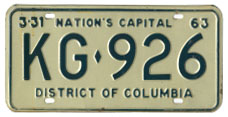 |
|
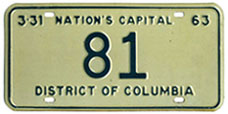 |
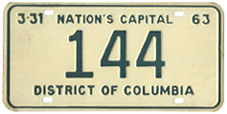 |
|
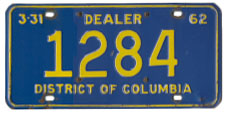 |
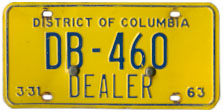 |
|
Top row General-issue passenger plates for 1961 and 1962 show the change from traditional painted to reflective plates. Middle row Most reserved-number plates were made with the same reflectivity method as plates of other types, with a background covered with reflective sheeting, but a relatively small number, such as 144, were made with an experimental (for D.C. at this time) glass-beaded background, presumably with materials provided by Flex-O-Lite Mfg. Corp. Bottom row Although many changes were made to dealer plates between 1961 and 1962, the addition of a reflective background is not one of them. Why the change was not applied to this type (for yellow sheeting was certainly available) is unknown. |
||
We have no documents on this subject from Sept. 1960 through June 1961, but it is clear that the time was spent considering whether the first reflective D.C. plates would be made with materials provided exclusively by Minn. Mining & Manufacturing, Flex-O-Lite Mfg. Corp., or possibly some other vendor. A telegram sent by Mr. Charles R. Dernbach, Sales Manager of Flex-O-Lite to the Commissioners on July 10, 1961, in which he protests the materials contract for 1962 D.C. plates having been awarded to 3M is our earliest evidence of the selection process and its result. The Western Union communique was followed by a long letter dated July 11 in which Mr. Dernbach expands upon the contents of his telegram. Specifically, he suggests that although a request for proposals for equipment and materials required to manufacture reflective plates was issued by the D.C. government in April 1961, the bid specifications were prepared in such a manner that only 3M could meet the requirements, which is to say that the method of reflectorization and vendor were effectively chosen without the benefit of a competitive bid process. "We are only one of several small manufacturers of reflective glass beads who must fight for enough business to keep going in the face of the competition from big business. All we are asking is to have our system accepted and then an opportunity to bid competitively against big business," wrote Mr. Dernbach.
Also in the Flex-O-Lite letter is information about the cost of equipment and finished plates. Although the smaller manufacturer did not know the cost of equipment required to produce plates with 3M's system, it indicated that a capital investment of only $2,000 would be required for the its machine used to spread glass beads on the embossed areas of painted plates. If plates with a background covered with glass beads was preferred, the necessary equipment would cost $8,000. Mr. Dernbach was, however, able to provide information about the cost of finished plates made with both reflectivity methods. He wrote that "it is estimated that the lowest priced reflective sheeting will cost about 11.5 cents per plate. Based on about 500,000 plates this is a total of $57,500 for material only. (A more costly material may have been proposed.) Materials to process the plates with the Flex-O-Lite System for the same quantity of plates would be about $12,500 for numeral and border reflectorization only, or about $25,000 to $30,000 for complete background reflectorization." In support of his company's products he noted that "The Flex-O-Lite System is now being used in the States of South Dakota, Louisiana, Hawaii, and the Commonwealth of Puerto Rico."
The Flex-O-Lite letter was sent to the Board of Commissioners, D.C. DMV and Dept. of Corrections representatives, and various other city and federal government officials, as well as Sen. Stuart Symington and Rep. Thomas Curtis, members of Congress then representing St. Louis, location of the company's home office. In almost identical replies sent to the Congressmen on July 27, Walter Tobriner, President of the Board of Commissioners, wrote "The Commissioners have carefully weighed the merits of the several processes of reflectorization, and have decided to use reflective sheeting material based on several advantages it has over the other processes, including the Flex-O-Lite System. Admittedly, the Flex-O-Lite System is less expensive, but cost in this instance is not the prime consideration since the program was adopted at the insistence of the citizens of the District of Columbia who have expressed their willingness to finance the most effective method of reflectorization." A similar response was dispatched to Mr. Dernbach, of Flex-O-Lite, who quickly responded with another appeal. "We would appreciate very much being advised just what these 'several advantages' are," he wrote in reference to Mr. Tobriner's July 27 letter. "We do not what they could be since our material is being purchased by several of the states based on meeting specifications that are open to more than one manufacturer." "We hope that it is not too late to reconsider the decision and at least permit competitive bidding with the Flex-O-Lite System being included instead of handing an order to a company who holds a virtual monopoly in the reflective sheeting business."
Rep. Curtis apparently had similar questions (probably due to the urging of Mr. Dernbach and other Flex-O-Lite executives), for on August 7 a letter drafted by DMV Director George England on behalf of Commissioner Tobriner was sent to the Congressman in which two advantages of the reflective sheeting method are specified: "1) Elements, including rain, alter the optical focus of exposed beads, resulting in substantial loss of reflection; 2) Exposed beads are inclined to rub off with wear, thereby diminishing the size of the reflective surface." "Since reflectorization, especially under adverse weather conditions, was the principal objective of the District's program, the Commissioners chose, in their opinion, the optical system most effective under all conditions," wrote Mr. England. These points were repeated in an August 21 letter sent to Mr. Dernbach by Mr. G.M. Thornett, Secretary of the Board of Commissioners. At this point the controversy seems to have abated, for no further communications about the reflectorization method of 1962 D.C. plates appears to have been exchanged.
Color Specifications
Official correspondence in which 1962, 1963, 1964, and 1965 D.C. plates are described provides these descriptions of their colors:
Year |
Embossed Areas |
Scotchlite Reflective Sheeting |
|||
1962 (exp. 3-31-63) |
dark green opaque | No. ALP3570 - Wide-Angle White |
|||
1963 (exp. 3-31-64) |
black | No. ALP3581 - Wide-Angle Yellow |
|||
1964 (exp. 3-31-65)
|
dark red opaque | No. ALP3570 - Wide-Angle White |
|||
1965 (exp. 3-31-66): |
|||||
single-year plates |
black | No. ALP3571 - Federal Yellow |
|||
multi-year plates |
black | white |
|||
For 1963, three possible colors were presented by DMV Director George England to the commissioners at their meeting of May 29, 1962: white, yellow, and salmon. "The Commissioners chose the lemon background with black numerals," according to a record of the meeting.

|
This page last updated on December 31, 2017 |
 |
|
copyright 2006-2018 Eastern Seaboard Press Information and images on this Web site may not be copied or reproduced in any manner without consent of the owner. For information, send an e-mail to admin@DCplates.net |













